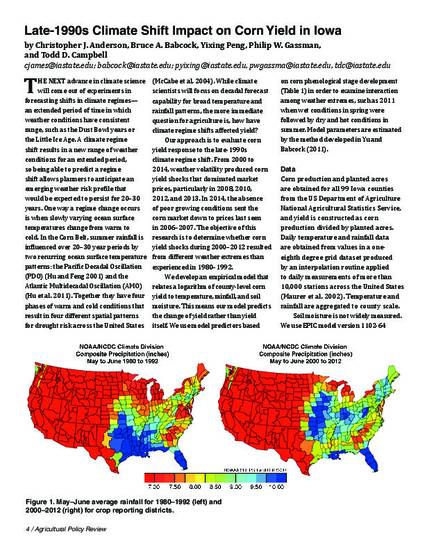
Article
Late-1990s Climate Shift Impact on Corn Yield in Iowa
Agricultural Policy Review
Publication Date
1-1-2015
Disciplines
Abstract
The next advance in climate science will come out of experiments in forecasting shifts in climate regimes—an extended period of time in which weather conditions have consistent range, such as the Dust Bowl years or the Little Ice Age. A climate regime shift results in a new range of weather conditions for an extended period, so being able to predict a regime shift allows planners to anticipate an emerging weather risk profile that would be expected to persist for 20–30 years. One way a regime change occurs is when slowly varying ocean surface temperatures change from warm to cold. In the Corn Belt, summer rainfall is influenced over 20–30 year periods by two recurring ocean surface temperature patterns: the Pacific Decadal Oscillation (PDO) (Hu and Feng 2001) and the Atlantic Multidecadal Oscillation (AMO) (Hu et al. 2011). Together they have four phases of warm and cold conditions that result in four different spatial patterns for drought risk across the United States (McCabe et al. 2004). While climate scientists will focus on decadal forecast capability for broad temperature and rainfall patterns, the more immediate question for agriculture is, how have climate regime shifts affected yield?
Citation Information
Christopher J. Anderson, Bruce A. Babcock, Yixing Peng, Philip W. Gassman, et al.. "Late-1990s Climate Shift Impact on Corn Yield in Iowa" (2015) Available at: http://works.bepress.com/bruce-babcock/146/
